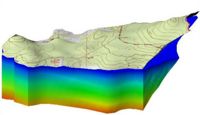GMS:3D Mesh Module: Difference between revisions
From XMS Wiki
Jump to navigationJump to search
No edit summary |
No edit summary |
||
| Line 1: | Line 1: | ||
{{3D Mesh links}} | {{3D Mesh links}} | ||
The 3D Mesh module is used to create and edit 3D finite element meshes. Once a mesh is constructed, the [[GMS:FEMWATER|FEMWATER]] interface can be used to assign boundary conditions and analysis parameters and perform a FEMWATER analysis. | The 3D Mesh module is used to create and edit 3D finite element meshes. Once a mesh is constructed, the [[GMS:FEMWATER|FEMWATER]] interface can be used to assign boundary conditions and analysis parameters and perform a FEMWATER analysis. | ||
The module includes tools for manipulating 3D meshes. Currently, only one 3D mesh can exist in a GMS project. | |||
[[Image:Sample_FEMWATER.JPG|thumb|none|left|350 px|Isosurface of Pressure Head from a FEMWATER Simulation]] | [[Image:Sample_FEMWATER.JPG|thumb|none|left|350 px|Isosurface of Pressure Head from a FEMWATER Simulation]] | ||


